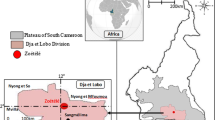Abstract
During construction of underground structure, cement slurry can be infiltrated into a coarse-grained soil and forms a cement infiltrated zone. This zone may serve as a part of structural element when the strength of this zone increases significantly. However, it is not easy to apply this effect in engineering practice due to many uncertainties associated with the infiltration mechanism and lack of researches on this topic. In this paper, the theories related to cement infiltration mechanisms are presented, and an experimental equation which predicts the cement infiltration depth is derived from the existing theories. Further, a prototype laboratory apparatus is devised to simulate the cement infiltration, and an experimental design was performed using the variables selected for the study. With the laboratory data, a statistical analysis was performed to identify the significant factors affecting the cement infiltration, and a regression model was derived to predict the infiltration depth. The study suggests that cement infiltration occur in coarse-grained soil; the infiltration depth can be predicted; and the infiltrated zone may be considered as a structural element.
Similar content being viewed by others
References
Bezuijen, A. (2010). Compensation grouting in sand: Experiments, field experiences and mechanisms, PhD Thesis, Delft University, Netherlands.
Brown, R. (1981). “Cement and clay as grouting materials.” Grouting In Engineering Practice, 2nd Ed., John Wiley & Sons, New York, pp 18–41.
Hausenbuiller, R. L. (1985). Soil science principles & practices third edition, Wm. C. Brown Publishers, Dubuque, Iowa.
Henry, F. D. C. (1986). The design and construction of engineering foundations 2nd Ed., Chapman and Hall, New York.
Ismael, N. F., Hasan A. A., and Fahad A. (1994). “Tension tests on bored piles in cemented desert sands.” Canadian Geotechnical Journal, Vol. 31, pp. 597–603.
Koerner, R. M. (1994). Grouting, construction and geotechnical methods in foundation engineering, McGraw-Hill, Inc., New York.
Kumer, M. P. (1986). Concrete at early ages, concrete structure, properties, and materials, Prentice-Hall, Inc., Englewood Cliffs, New Jersey, pp. 300–342
Kurian, N. P. (2005). “Design of foundation systems: Principles and practices.” Alpha Science International, Harrow, Middlesex, UK.
Lambe, T. W. (1951). Permeability test, soil testing for engineers, John Wiley & Sons, New York.
Meyerhof, G. G. (1959). “Compaction of sands and bearing capacity of piles.” Journal of the Soil Mechanics and Foundations Division, ASCE, Vol. 85, SM6, No. 1.
Mitchell, J. K. and Katti, R. K. (1981). “Soil improvement — State of art Report.” Proc. 10 th Int. Conf. Soil Mech. & Found. Eng., Vol. 4, stockholm, Balkema, Rotterdam.
Norusis, Marija J. (1985). SPSSx advanced statistics guide, McGrew-Hill Book Company, New York.
Norusis, Marija J. (2005). SPSS base 14 user’s guide, SPSS Inc., Chicago.
Popovics, Sandor. (1982). Fundamentals of portland cement concrete: A quantitative approach, Fresh Concrete, John Wiley & Sons, New York.
Raymond, W. H. and Nathan, C. S. (2010). Ultrafine cement in pressure grouting, ASCE.
Rodin, S. (1963). “Pressure of concrete on formwork.” Structure Concrete, Vol. 1, No. 10, pp. 445–453.
Samtani, N. C. and Edward, A. N. (2006). Soils and foundations reference manual, FHWA Manual.
Scheaffer, R. L. and James T. M. (1986). Probability and statistics for engineers, 2nd Ed., Duxbury Press, Boston.
Spangler, M. G. and Richard L. H. (1982). Soil Engineering, 4th Ed., Harper & Row, Publishers, New York.
Van der Stoel, A. E. C. (2001). Grouting for pile foundation improvement, PhD Thesis, Delft University, Netherland.
Van der Stoel, A. E. C. (2003). “Pile foundation improvement by permeation grouting.” Grouting & Ground Treatment, Proc. of the 3rd Intern. Conference DFI / ASCE, New Orleans.
Verruijt, A. (2010). Soil mechanics, Delft University of Technology, Netherlands.
Xanthakos, P. P. (1979). Slurry walls, McGraw-Hill, Inc., New York.
Author information
Authors and Affiliations
Corresponding author
Rights and permissions
About this article
Cite this article
Park, HK., Chang, Y.C. Prediction of cement infiltration depth in coarse-grained soil. KSCE J Civ Eng 17, 886–894 (2013). https://doi.org/10.1007/s12205-013-0288-y
Received:
Accepted:
Published:
Issue Date:
DOI: https://doi.org/10.1007/s12205-013-0288-y



